Environmental Injustice Case: Coal in South Africa
The Issue
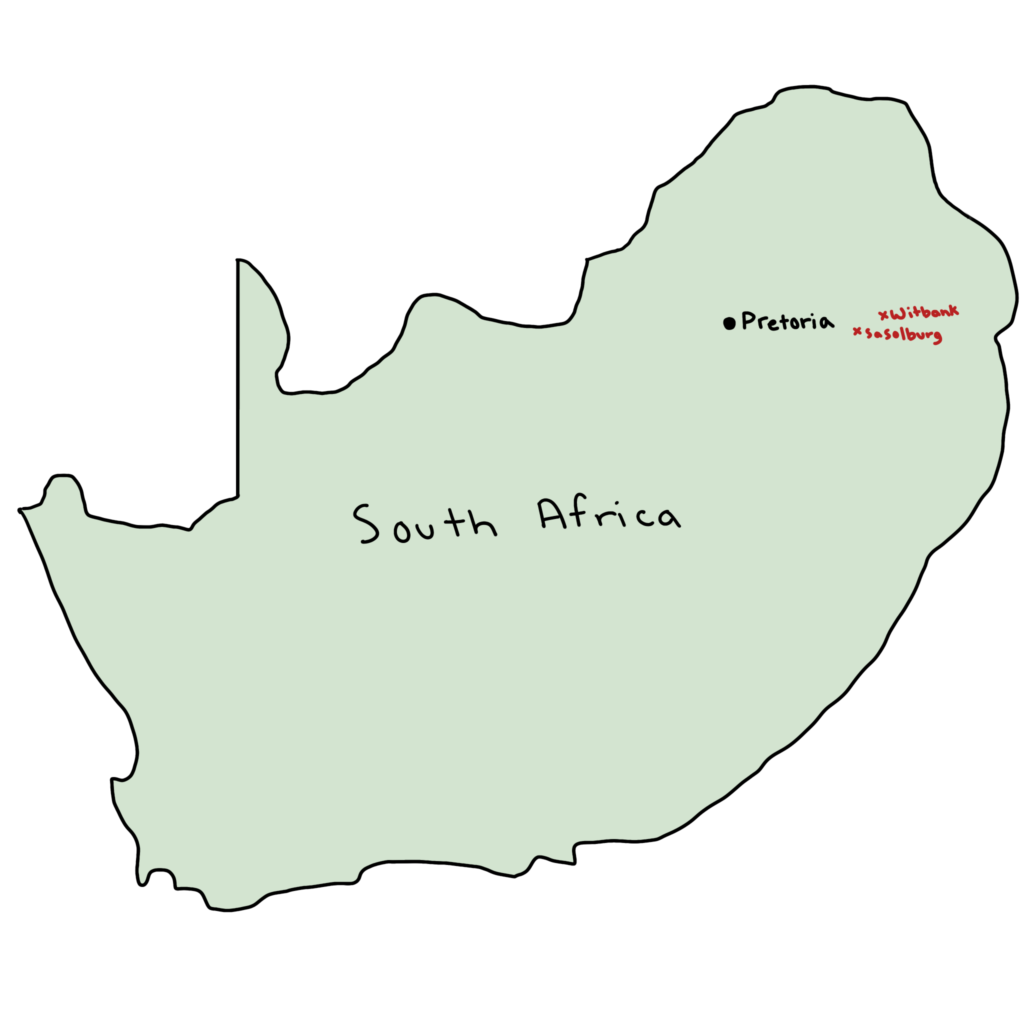
Figure 1. Region of South Africa and coal mines of Witbank and Sasolburg (red) (Drawn by Ereign).
South Africa has shown ecological collapse in their environment. Combustion of coal releases toxic chemicals into the atmosphere. Affecting the communities near coal mines such as Witbank and Sasolburg (Figure 1). Damaged land resulted in polluted neighborhoods near coal fired power stations, steel mills, incinerators and waste sites (Cock 2015). Results in devastating impacts among South Africans without access to clean water, air and services. This is evident among social economic class with rising food prices, crop failures and water shortages. Reports have shown that global construction industries are consuming more amounts of raw materials compared to any other economic activity (Orevaoghene et al. 2007). This causes environmental injustice among miners, mining and processing the coal to accumulate big volumes creating threat to the environment and communities near coal mines.
History
 Coal in Africa. (1650) (Martinelli).
Coal in Africa. (1650) (Martinelli).
Charcoal is a vital tool in the South African economy. It is more precious to their economy than gold(Snyman). Coal is a form of nonrenewable energy source that has been used by South Africans for a number of years. From 300 to1880 years coal was used in South Africa during the iron age(Snyman). During this time period charcoal was used to melt iron and copper. Coal helps power the country’s economy by providing a cheaper form of energy to the business, helps with transportation and communication systems, and helps provide energy for cooking, lighting and heating. Coal provides a number of services to the country’s economy that without it it will be hard for them to live their day to day life(Wybergh). According to the South African Department of Energy, 77% of South Africa’s energy needs are provided by coal, coal-fired stations produce about 90% of electricity(Wybergh). power(Davenport ). In 1936- South Africa entered a period of industrialization during and after WW2(Snyman). During this period the demand for coal increased. Coal sector is in local private hands(those of old mining houses). In 1995- around one million low income South Africans families relied on coal for cooking, lighting and heating(Davenport).
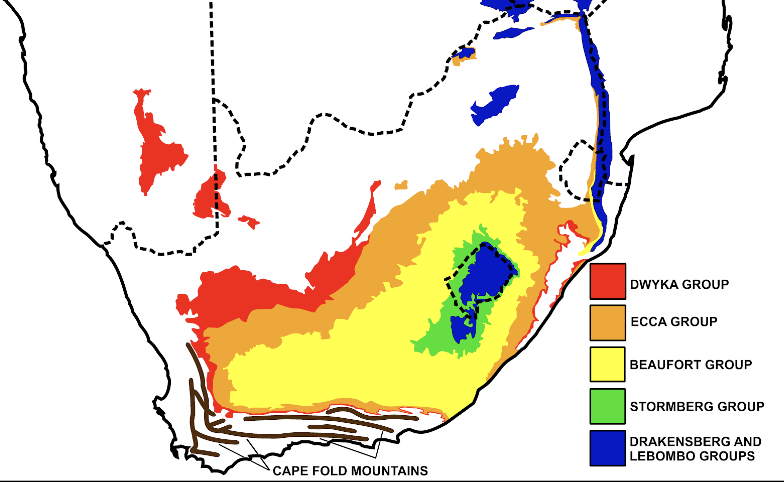 South Africa coal happening in the Ecca group(2010)(Schmidt).
South Africa coal happening in the Ecca group(2010)(Schmidt).
People affected
 Figure 4. The demographic of South Africa by race and the general areas that the populations are living in. (MC 2018)
Figure 4. The demographic of South Africa by race and the general areas that the populations are living in. (MC 2018)
The coal mining industry has had many effects on the surrounding communities all ranging from providing jobs to cause toxic living environments. Many people living close to or near the mining areas have told their concerns about health to the Government but are unable to be heard. The demographic of South Africa is majority black South Africans who make up roughly 80% of the population (MC 2018). The pollution from the coal mining areas affects many Black South Africans, who are concerned by the pollution’s effects on their children’s health.
 Figure 5. These are some of the young miners that worked for the coal mining industry. (Mugubane 1988)
Figure 5. These are some of the young miners that worked for the coal mining industry. (Mugubane 1988)
Many farmers who relied on land to help them survive were also impacted by the pollution of the coal mines. They were pressured to have their land confiscated without compensation (Rall 2018). They were left with no way to live and no land to farm on which caused lots of families to be in dire situations. Shutting down the coal industry would not be a viable solution to these issues as it would cause widespread unemployment for many who work in the industry. The figure below shows young mine workers who had come to the mining industry to look for work to make money.
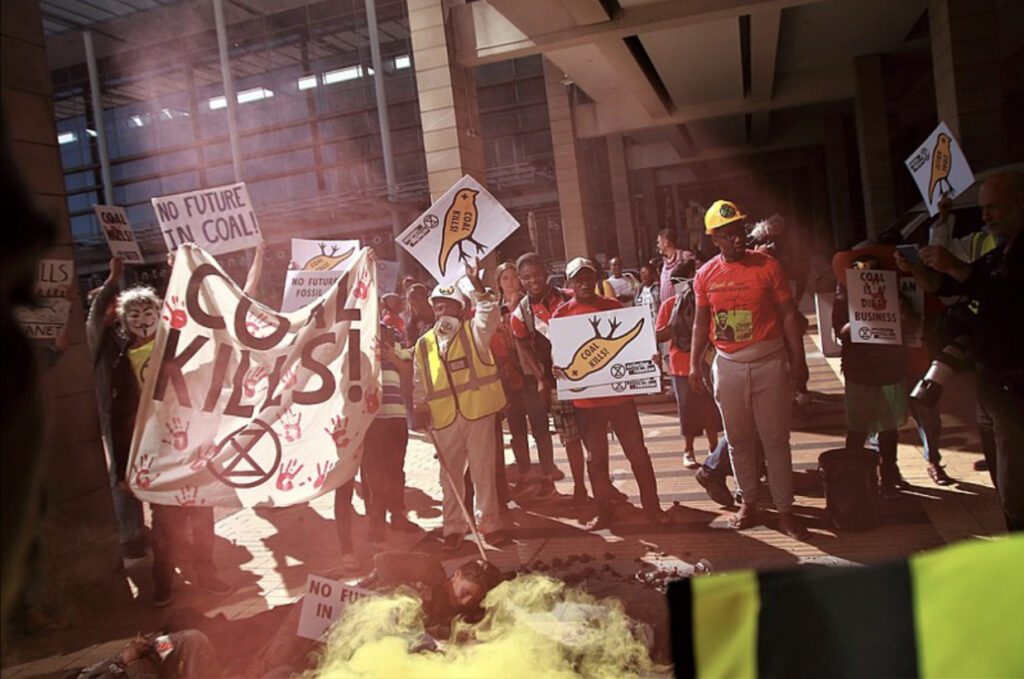 Figure 6. The pollution of using and producing coal has negatively impacted the health of South Africans. Many have died due to the pollution of the air and water. (Rack 2020)
Figure 6. The pollution of using and producing coal has negatively impacted the health of South Africans. Many have died due to the pollution of the air and water. (Rack 2020)
The people affected aren’t only having their livelihood taken away, but they also have to suffer through polluted living conditions. There have been estimated to be around 3.7 premature deaths due to the air pollution that the use of coal has cost (Siegfried 2014). Air pollution was a group 1 classified carcinogen that could lead to serious lung damage and declining health (Gasparotto and martinello 2021).
Impact on environment
Discarding coal produced in South Africa is more than 1.5 billion tons, with approximately 60 million tons produced annually (Orevaoghene et al. 2007). The breakdown of disposing coal has been a challenge to the industry due to stockpiling them resulting in severe environmental concerns. Resulting in spontaneous combustion, air pollution and contamination of aquifers and useful land space (Orevaoghene et al. 2007). As well, combustion has shown to contain hazardous trace elements associated with health risk and poor aerosol pollution among communities (Figure 7). Overseas coal combustion-derived particulate matters (nanoparticles) containing hazardous trace elements that are associated with the aspects of health risk and environmental pollution (Lungile Sumbane-Prinsloo et al. 2020).
Figure 7. Impact of discarding coal on the environment (Drawn by Ereign).
Health Effects of Coal
Exposure to coal results in lung diseases. A particular lung disease is called chronic obstructive pulmonary disease also known as COPD (Finkleman, 2020).
 Figure 8. The comparison between a healthy lung vs. a lung with COPD (Image created by Jasmeet Kaur).
Figure 8. The comparison between a healthy lung vs. a lung with COPD (Image created by Jasmeet Kaur).
The effects of COPD are shown in Figure 8. COPD affects the patient’s lungs by narrowing and congesting the tubes of the bronchioles. Bronchioles are small branches in our lungs that lead to air sacs called alveoli. In COPD patients, alveoli get degraded. Overall, the patient’s respiratory system could get permanently impaired.
- The World Health Organization says that COPD is the third main cause of death worldwide. (Alfahad, 2021)
- 3 million people die from this disease every year globally. (Alfahad, 2021)
- 90% of people affected by this disease are from low to middle-income countries. (Alfahad, 2021)
Another known lung disease that could be caused by the exposure to coal is pneumoconiosis, also known as “Black Lung Disease” (Finkleman, 2020). This disease is often found in coal miners.
 Figure 9. (Left) a healthy lung, (Right) a lung affected by pneumoconiosis. (Image created by Jasmeet Kaur).
Figure 9. (Left) a healthy lung, (Right) a lung affected by pneumoconiosis. (Image created by Jasmeet Kaur).
Figure 9 shows the severe inflammation in the lungs of a pneumoconiosis patient (on the right). This disease causes the lungs to stiffen, which leads to difficulty breathing. The lungs start to grow abnormal tissue (nodules), which leads to progressive reparative organ tissue to form (fibrosis). This disease could be fatal, as it is irreversible and requires treatment (Xiao, 2021).
Respiratory issues are the main diseases caused by coal and its dust. Coal miners are highly impacted by these diseases due to their daily exposure that comes from their jobs.
What can be done
Coal is predominantly used as an energy source. So a potential solution to coal’s harmful effects could be an alternative energy source. There are many alternative energy sources that are more renewable and cleaner than coal. One example of an alternative energy source is biomass gasification. This method is a widespread renewable energy source and is not new to the world. Figure 10 shows the process of biomass gasification.
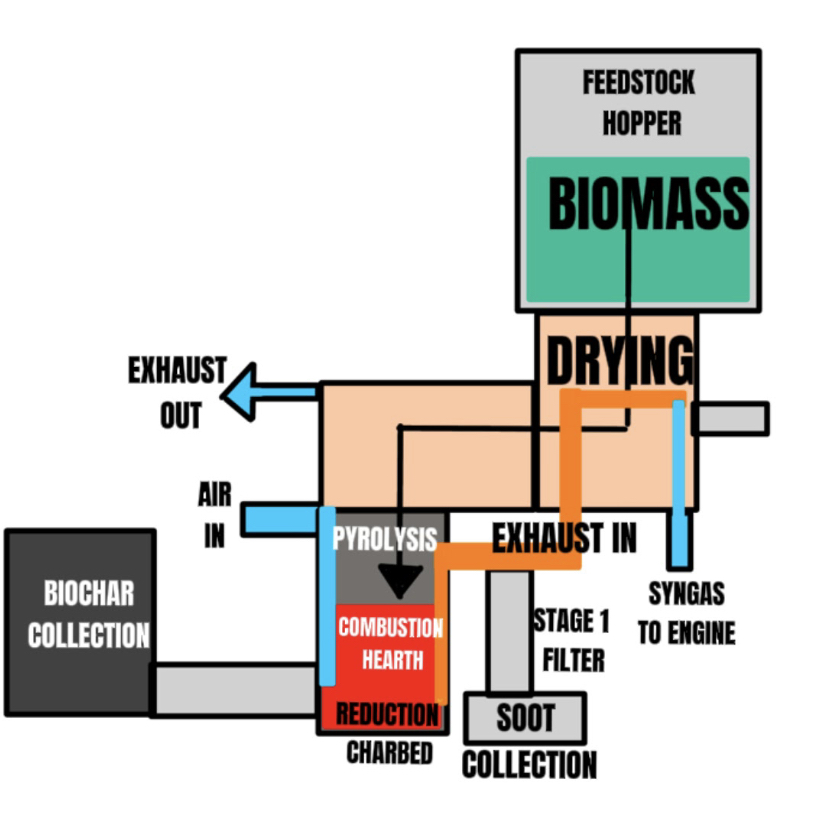 Figure 10. A process of biomass gasification. (Image created by Jasmeet Kaur).
Figure 10. A process of biomass gasification. (Image created by Jasmeet Kaur).
What about the diseases? For pneumoconiosis, early treatment is the best way to manage the illness. The International Labor Organization says that chest radiography is the most accessible and affordable radiological test for workers with pneumoconiosis. (Xiao, 2021). For further reading on chest radiography, read the article “Deep Learning in Chest Radiography: Detection of Pneumoconiosis” by Xiao.
For COPD, there is a treatment that involves the use of Yoga, that includes breathing exercises, meditation, counseling and lectures (Rajashree, 2016). In a study by Rajashree, what they found was that in patients with COPD, yoga therapy reduced dyspnea; fatigue and PR, and improved functional performance and peripheral capillary SpO2%. For further reading on yoga therapy for COPD, read the article “Yoga-based pulmonary rehabilitation for the management of dyspnea in coal miners with chronic obstructive pulmonary disease: A randomized controlled trial” by Rajashree.
Conclusion
In conclusion coal mining and using coal as a power source has been an important way for South Africa to produce electricity for their people. It was a method that they relied on for many years since the cost of using coal was so cheap, many low income families relied on it to produce power to use their appliances. Though it is an affordable way for people to have electricity and power there are a lot of environmental impacts that would leave lasting effects on the land and on the people who live on it. The neighborhoods that are near these polluted sites are having issues with access to clear air and water. They would have to breathe in more inorganic impurities and dust which could lead to devastating health conditions. Hopefully in the coming years there will be an affordable renewable source of energy that will be passed through so that those who have to live near these polluted areas will be able to have access to better living conditions and children are able to play outside without worrying about their health.
Works cited
Cock Jacklyn. 1 November 2015. How the environmental justice movement is gathering momentum in South Africa. University of the Witwatersrand. [accessed 2021 Oct 25]
Denis J. 1 October 2007 .The spontaneous combustion of coal and its by-products in the Witbank and Sasolburg coalfields of South Africa. International Journal of Coal Geology. [accessed 2021 Oct 25].
https://www.sciencedirect.com/science/article/pii/S0166516207000122
Davenport J. 2013. Digging deep : a history of mining in South Africa, 1852-2002. Johannesburg ; Cape Town: Jonathan Ball Publishers.Gasparotto J, Martinello KDB. 2021. Coal as an energy source and its impact on human health. ScienceDirect. 2:[113-120 p.] Doi: https://doi.org/10.1016/j.engeos.2020.07.003
Issac K and Bada S. The co-combustion performance and reaction kinetics of refuse derived fuels with South Africa high ash coal. 6(1): [p.9]. Doi: https://doi.org/10.1016/j.heliyon.2020.e03309
https://www.sciencedirect.com/science/article/pii/S2405844020301547
Lungile Sumbane-Prinsloo et al.2020. The effect of particle size on the pollution reduction potential of a South African coal-derived low-smoke fuel. Energy Geoscience.1(3):165-173.https://doi.org/10.1016/j.engeos.2020.06.006.[Accessed 202021 Nov 4].
https://www.sciencedirect.com/science/article/pii/S2666759220300470
Minerals Council South Africa. 2019. Marshalltown (IA): Minerals Council South Africa. [accessed 2021 Oct 25]
https://www.miningforschools.co.za/lets-explore/coal/brief-history-of-coal-mining-in-south-africa
Martinelli, B., 2004, “On the Threshold of Intensive Metallurgy – The choice of Slow Combustion in the Niger River Bend (Burkina Faso and Mali)” in The origins of iron metallurgy in Africa – New lights on its antiquity, H. Bocoum (ed.), UNESCO publishing : pp. 216–247
Mkhize V. 2021 Nov 02.COP26: South Africa hails deal to end reliance on coal. London (UK):
BBC Africa Business. [accessed 2021 Nov 04]. https://www.bbc.com/news/world-africa-59135169
Mugubane P. 1988. Young coal miners in South Africa, South Africa: United Nations. [accessed
2021 Nov 05]. https://www.flickr.com/photos/un_photo/3311470533
MC A. 2018. South Africa’s population. South Africa Gateway. [accessed 2021 Nov 05].
https://southafrica-info.com/people/south-africa-population/
Orevaoghene Eterigho-Ikelegbe et al. 26 May 2021. Preparation and characterization of ceramic composites from South Africa coal discard. Oviedo (Fl):Construction and Building Materials [accessed 2021 Oct 25].
https://www-sciencedirect-com.offcampus.lib.washington.edu/science/article/pii/S0950061821019243
Rack K.K. 2020. Pollution from Coal-fired power stations kills more than 2,200 South Africans every year.jpg [image]. South Africa. Wikimedia Commons. [accessed 2021 Nov 29]. https://commons.m.wikimedia.org/wiki/File:Pollution_from_Coal-fired_power_stations_kills_more_than_2,200_South_Africans_every_year.jpg
Rall K. 2018 Aug 27. South Africa: How Mining Damages Communities and the Environment. Human Rights Watch.New York (NY) [accessed 2021 Nov 04]
https://www.hrw.org/news/2018/08/27/south-africa-how-mining-damages-communities-and-environment
Siegfried K. 2014. South Africa’s coal-fired power stations carry heavy health costs. Masakhane (South Africa): TheGuardian [accessed 2021 Nov 29].
Snyman C., Botha W. 1993. Coal in South Africa. Journal of African earth sciences, and the Middle East. 16(1):171–180. doi:10.1016/0899-5362(93)90165-M.
Schmidt, Stephan. “Coal deposits of South Africa – the future of coal mining in South Africa” (PDF). Institute for Geology, Technische Universität Bergakademie Freiberg. Retrieved 14 January 2010.
Wybergh WJ, Geological Survey. 1922. The coal resources of the Union of South Africa. Pretoria: Government Printing and Stationery Office.
Rajashree R. (2016).Yoga-based pulmonary rehabilitation for the management of dyspnea in coal miners with chronic obstructive pulmonary disease: A randomized controlled trial. Journal of Ayurveda and Integrative Medicine, 7(3), 158-166. [accessed 2021, Nov 29] https://www.sciencedirect.com/science/article/pii/S0975947616301474
Ahmed J. (2021). Current views in chronic obstructive pulmonary disease pathogenesis and management. Saudi Pharmaceutical Journal. [accessed 2021, Nov 29]
https://www.sciencedirect.com/science/article/pii/S1319016421002103
Robert B. Finkelman. (2021). The future environmental and health impacts of coal. Energy Geoscience, 2(2), 99-112. [accessed 2021, Nov 29]
https://www.sciencedirect.com/science/article/pii/S2666759220300706#!
Xiao LI. (2021). Deep Learning in Chest Radiography: Detection of Pneumoconiosis. Biomedical and Environmental Sciences, 34(10), 842-845. [accessed 2021, Nov 29]
https://www.sciencedirect.com/science/article/pii/S0895398821001367#!
Faith Tokologo Mdhluli. (2021). Comparative life-cycle assessment of maize cobs, maize stover and wheat stalks for the production of electricity through gasification vs traditional coal power electricity in South Africa. Cleaner Environmental Systems, 3. [accessed 2021, Nov 29]
https://www.sciencedirect.com/science/article/pii/S2666789421000386#!
Narnaware Sunil. (2021). Biomass gasification for climate change mitigation and policy framework in India: A review. Bioresource Technology Reports. [accessed 2021, Nov 29]
https://www.sciencedirect.com/science/article/abs/pii/S2589014X2100270X#!
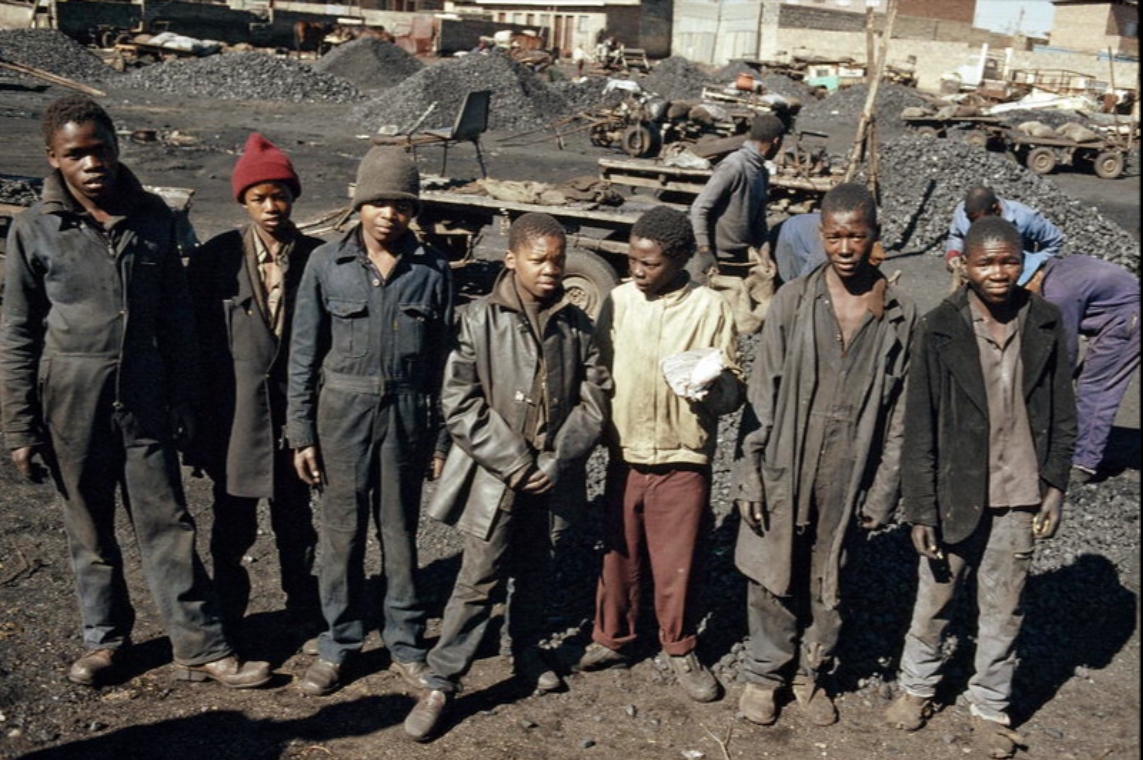

Provide Feedback